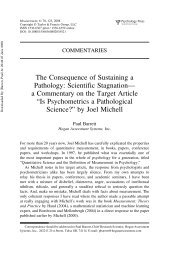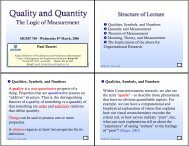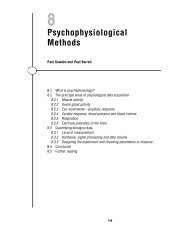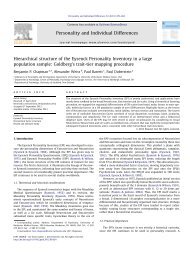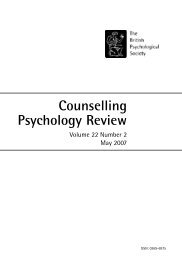Dimensions of variation on the CORE-OM - Paul Barrett
Dimensions of variation on the CORE-OM - Paul Barrett
Dimensions of variation on the CORE-OM - Paul Barrett
You also want an ePaper? Increase the reach of your titles
YUMPU automatically turns print PDFs into web optimized ePapers that Google loves.
Copyright © The British Psychological SocietyReproducti<strong>on</strong> in any form (including <strong>the</strong> internet) is prohibited without prior permissi<strong>on</strong> from <strong>the</strong> SocietyTable 5. Model comparis<strong>on</strong>s<str<strong>on</strong>g>Dimensi<strong>on</strong>s</str<strong>on</strong>g> <str<strong>on</strong>g>of</str<strong>on</strong>g> <str<strong>on</strong>g>variati<strong>on</strong></str<strong>on</strong>g> <strong>on</strong> <strong>the</strong> <strong>CORE</strong>-<strong>OM</strong> 199Models compared(<strong>the</strong> first <str<strong>on</strong>g>of</str<strong>on</strong>g> each pair has significantly better fit) Chi square Degrees <str<strong>on</strong>g>of</str<strong>on</strong>g> freedom<strong>CORE</strong>-<strong>OM</strong> (1b) vs. SGF þ Risk(3a) 320.33 5<strong>CORE</strong>-<strong>OM</strong> þ GF(4b) vs. <strong>CORE</strong>-<strong>OM</strong>(1b) 1,306.67 26MF þ Risk(5) vs. <strong>CORE</strong>-<strong>OM</strong>(1b) 441.09 3<strong>CORE</strong>-<strong>OM</strong> þ GF(4b) vs. SGF þ Risk (3a) 1,627.00 31<strong>CORE</strong>-<strong>OM</strong> þ GF(4b) vs. MF þ Risk(5) 865.58 29MF þ GF þRisk (6) vs. MF þ Risk(5) 1,247.05 29MMMT þ GF(7) vs. MF þ GF þ Risk(6) 812.22 28MMMT þ GF(7) vs. <strong>CORE</strong>-<strong>OM</strong> þ GF(4b) 1,193.69 28SGF ¼ single general factor latent; GF ¼ general factor latent; MF ¼ method factor latents;MMMT þ GF ¼ multi-method, multi-trait model with general factor latent.Discussi<strong>on</strong>This cross-secti<strong>on</strong>al study has compared a range <str<strong>on</strong>g>of</str<strong>on</strong>g> structural models for <strong>CORE</strong>-<strong>OM</strong>based <strong>on</strong> data from a large sample <str<strong>on</strong>g>of</str<strong>on</strong>g> clients in psycho<strong>the</strong>rapy and counselling services.In additi<strong>on</strong>, <strong>the</strong> psychometric quality <str<strong>on</strong>g>of</str<strong>on</strong>g> two <strong>CORE</strong>-<strong>OM</strong> scoring keys has been assessed.The results <str<strong>on</strong>g>of</str<strong>on</strong>g> <strong>the</strong> present study are not inc<strong>on</strong>sistent with a picture that has beenemerging in <strong>the</strong> validati<strong>on</strong> work to date, however it is now possible to present a moredefinitive assessment <str<strong>on</strong>g>of</str<strong>on</strong>g> <strong>the</strong> psychometric structure <str<strong>on</strong>g>of</str<strong>on</strong>g> <strong>CORE</strong>-<strong>OM</strong>.Risk domainIt has been c<strong>on</strong>firmed that when <strong>the</strong> six risk items are separated into <strong>the</strong> face validdomains for risk-to-self and risk-to-o<strong>the</strong>rs, <strong>the</strong> four risk-to-self items form a single latentvariable, leaving <strong>the</strong> risk-to-o<strong>the</strong>rs items as clinical flags. Fur<strong>the</strong>rmore, it has been shownthat combining <strong>the</strong> risk-to-self factor into a general factor for psychological distress,toge<strong>the</strong>r with all <str<strong>on</strong>g>of</str<strong>on</strong>g> <strong>the</strong> o<strong>the</strong>r n<strong>on</strong>-risk <strong>CORE</strong>-<strong>OM</strong> items (Model 3b), results in a worsefitting model than if <strong>the</strong> risk-to-self factor is modelled separately (Model 3a).<strong>CORE</strong>-<strong>OM</strong> structureRepresenting <strong>CORE</strong>-<strong>OM</strong> as a measure <str<strong>on</strong>g>of</str<strong>on</strong>g> <strong>the</strong> correlated domains <str<strong>on</strong>g>of</str<strong>on</strong>g> subjective well-being,psychological problems, and functi<strong>on</strong>ing, toge<strong>the</strong>r with a correlated risk-to-self latent(excluding items 6 and 22) resulted in a poor fit (Model 1b). A model in which <strong>the</strong> threedomains were collapsed into a general factor latent, with risk-to-self as a correlated latent,mirroring <strong>the</strong> alternative scoring key for <strong>CORE</strong>-<strong>OM</strong>, (Model 3a) also resulted in poor fit.A nested factors model with a general factor latent for <strong>the</strong> n<strong>on</strong>-risk items and fourresidualized first-order latents for risk-to-self, and <strong>the</strong> o<strong>the</strong>r three domains (Model 4b)resulted in a noticeably better fit than Models 1b or 3a, indicating that <strong>the</strong> four <strong>CORE</strong>-<strong>OM</strong> domain factors and <strong>the</strong> general factor both make a c<strong>on</strong>tributi<strong>on</strong> to model fit bey<strong>on</strong>d<strong>the</strong> c<strong>on</strong>tributi<strong>on</strong> <str<strong>on</strong>g>of</str<strong>on</strong>g> ei<strong>the</strong>r <strong>the</strong> general factor or <strong>the</strong> domain factors al<strong>on</strong>e.Previous validati<strong>on</strong> work using exploratory factor analysis failed to find a factorstructure that replicated <strong>the</strong> <strong>CORE</strong>-<strong>OM</strong> domain score key, but found separate factors forpositively and negatively worded items (Evans et al., 2002), suggesting that methodfactors might have an important part to play in explaining <strong>the</strong> covariance am<strong>on</strong>gst<strong>CORE</strong>-<strong>OM</strong> items. C<strong>on</strong>sistent with this finding, Model 5 comprising three correlated



